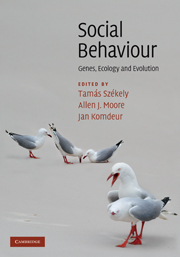Book contents
- Frontmatter
- Contents
- List of contributors
- Introduction: The uphill climb of sociobiology: towards a new synthesis
- Profile: Undiminished passion
- Part I Foundations
- Part II Themes
- Part III Implications
- 16 Personality and individual social specialisation
- Profile: Behavioural ecology, why do I love thee? Let me count the reasons
- 17 Molecular and genetic influences on the neural substrate of social cognition in humans
- Profile: Anonymous (and other) social experience and the evolution of cooperation by reciprocity
- 18 Population density, social behaviour and sex allocation
- Profile: Social theory based on natural selection
- 19 Social behaviour and speciation
- Profile: Look to the ants
- 20 Social behaviour in conservation
- Profile: The handicap principle and social behaviour
- 21 Prospects for research in social behaviour: systems biology meets behaviour
- Species index
- Subject index
- References
Profile: Behavioural ecology, why do I love thee? Let me count the reasons
Published online by Cambridge University Press: 05 June 2012
- Frontmatter
- Contents
- List of contributors
- Introduction: The uphill climb of sociobiology: towards a new synthesis
- Profile: Undiminished passion
- Part I Foundations
- Part II Themes
- Part III Implications
- 16 Personality and individual social specialisation
- Profile: Behavioural ecology, why do I love thee? Let me count the reasons
- 17 Molecular and genetic influences on the neural substrate of social cognition in humans
- Profile: Anonymous (and other) social experience and the evolution of cooperation by reciprocity
- 18 Population density, social behaviour and sex allocation
- Profile: Social theory based on natural selection
- 19 Social behaviour and speciation
- Profile: Look to the ants
- 20 Social behaviour in conservation
- Profile: The handicap principle and social behaviour
- 21 Prospects for research in social behaviour: systems biology meets behaviour
- Species index
- Subject index
- References
Summary
Behavioural ecology is the study of how behaviour is influenced by natural selection in relation to ecological conditions. It is a relatively new field – about 40 years old – to which I have been an enthusiastic contributor for 30 years. During this time behavioural ecology has grown in popularity, empirical richness and theoretical sophistication. Around the world, behavioural ecologists are employed in universities, conservation organisations and government agencies; they have been elected to national academies of sciences, and received prestigious prizes (Crafoord, Cosmos, Kyoto); at least a dozen scientific journals publish articles on behavioural ecology; and the biennial meeting of the International Behavioral Ecology Society regularly draws more than 1000 participants.
Why is behavioural ecology so appealing? For me, a curious naturalist, it is the challenge of asking new questions, the fun of addressing them using the theoretical framework pioneered by Darwin and embellished by Williams, Hamilton, Maynard Smith, Trivers and Dawkins and the empirical approaches pioneered by Tinbergen, Lack and Goodall, as well as the deep satisfaction of cracking an unsolved puzzle – at least occasionally. For example, in my case, why do bank swallows breed colonially, why do Belding's ground squirrels give alarm calls and how do they recognise half-sisters, why do wood ducks lay multiple parasitic eggs, why do queens of many social insects mate so frequently, why do naked mole-rats live like eusocial insects, and how have bdelloid rotifers survived and speciated without sex for 40 million years?
- Type
- Chapter
- Information
- Social BehaviourGenes, Ecology and Evolution, pp. 442 - 445Publisher: Cambridge University PressPrint publication year: 2010



